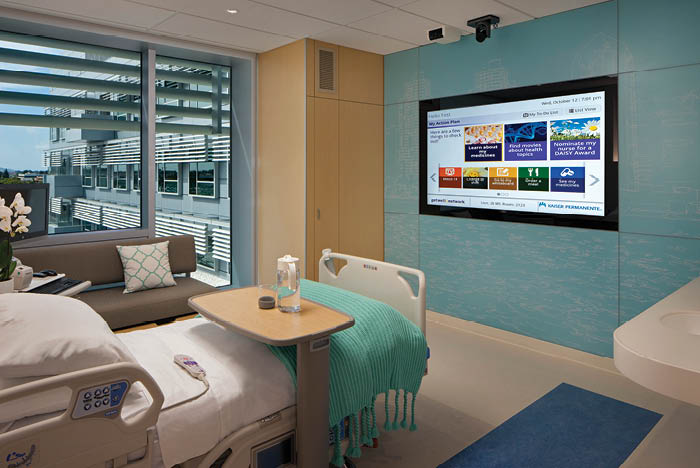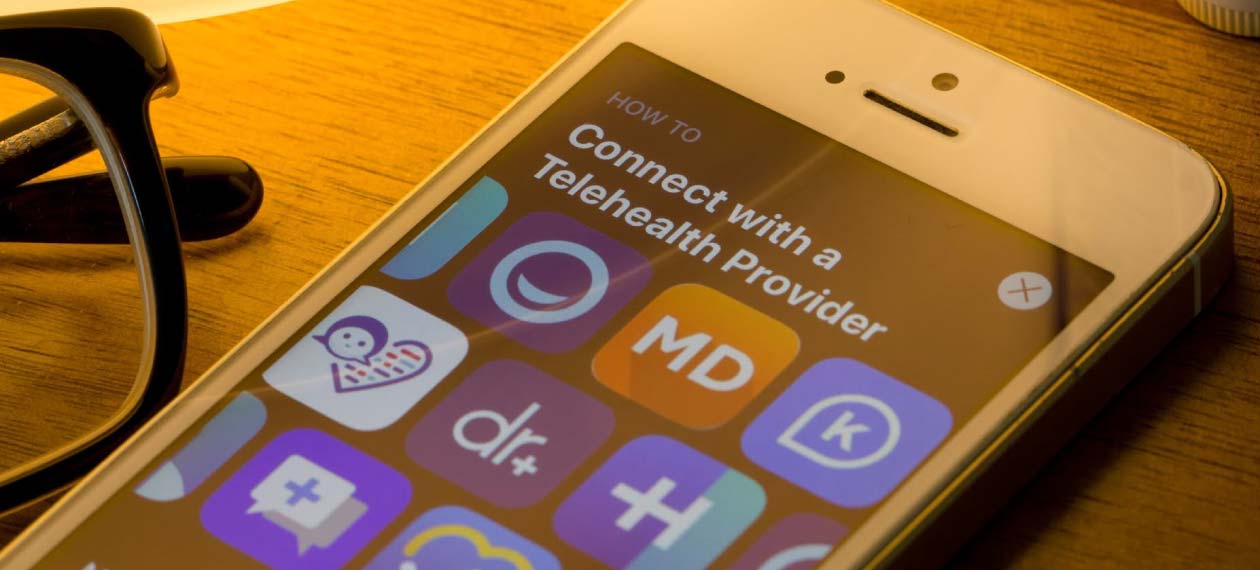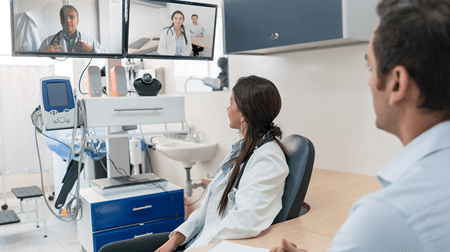At the beginning of this year, telehealth was still in its infancy. Now it is an essential component of healthcare services, and will continue to be so even in the post-pandemic future—to the tune of upwards of $250 billion. And while telehealth is completely transforming how providers deliver care and how patients access it, this digital healthcare revolution also has some implications for the future of physical healthcare spaces.
Among the most obvious and most frequently used applications of telehealth are low-risk urgent care televisits, COVID-19 symptom screening, mental and behavioral health services, monitoring of chronic medical conditions, and medication management. It can also be used in a hybrid approach for physical and occupational therapy, pre-op screening, post-op follow-up and monitoring, weight management and nutrition counseling, as well as improving access for patients in long-term care facilities and rural areas. There are also a substantial number of potential applications in a variety of sub-specialties.
In short, while telehealth use has accelerated exponentially in recent months, this is still just the beginning. A report by McKinsey & Co. estimated that physicians saw between 50 and 175 times more patients through telemedicine than they did before the pandemic, and while there is inevitably going to be some retraction in those numbers as people become more comfortable visiting their doctors' offices again, the truth is telehealth is simply safer – even in non-COVID times – and more convenient.
Telehealth Integration for Flexible Care
While it remains to be seen the extent to which the adoption of telehealth will impact physical spaces, it is safe to assume there will be some kind of impact. It's time to make the necessary changes to prepare for the continued growth of telehealth in the future, and to adapt your facilities as needed to accommodate it.
"With COVID-19 as the catalyst, telehealth has seen rapid growth and surprising acceptance from both the physician and patient communities," said Sandy Smith, SVP of Real Estate and Facilities at Hoag. "Our challenge will be to provide a fully integrated experience and see if we can use these technologies to improve access and the quality of the care."
He adds that while it remains to be seen what proportion of healthcare becomes virtual and what will remain physical, the key is to remember that it should be about the patient experience and outcomes.

Photo credits: Health Facilities Management Magazine
Patient rooms in Kaiser Permanente San Diego hospital are equipped with monitors and two-way video for telehealth appointments as well as entertainment, educational programs, food orders and more.
One way that telehealth can be leveraged to improve the patient experience and outcomes is to integrate telehealth tools in all patient rooms, exam rooms, and conference rooms. Kaiser Permanente is doing this with a mix of telehealth-equipped mobile carts that can be wheeled from room to room as well as fully integrated patient rooms with monitors and two-way videos. The focus is on flexibility, so that these tools are available to both patients and providers in a variety of different situations and modalities.
Is It Time to Cut Back on the Number of Exam Rooms?
The adoption of telehealth does have some implications for real estate as well, not just in how physical spaces might need to be integrated with technology but also in how much physical space is still needed.
"One of the metrics we like to talk about is what is the number of patients we're seeing per room per day," said Rick Redetzke, System VP of Facilities & Real Estate at SSM Health. "When you do that math many times and you say we have 100 exam rooms and we saw 250 patients today, well that's 2.5 patients per room per day – that just doesn't feel efficient."
He said that in thinking broadly about strategy, there are many different factors that come into play, and telehealth is just one of them. They have to think about all of the real estate assets that they have and how best to utilize those assets.
"I don't know that it's really a telehealth vs. in-person visit answer; it's really additive in thinking about telehealth as a means to improve health and provide access and engagement with our patients as opposed to 'how many exam rooms do I not have to build in the market now,'" he said. "Everybody's going to be incorporating telehealth and it's going to be a vital aspect of how we engage with our patients."
|
Photo credit: Healthcare IT News |
For John Dowaschinski, Chief Development Officer at ClearChoice, a national network of dental implant centers, telehealth has allowed their clinics to do a lot of the preliminary consultation work as well as post-implant follow-up and aftercare. While he doesn't see telehealth changing their standard number of exam rooms in their build outs, it will most likely allow them more time before the third and fourth exam rooms need to get activated at new centers. It also allows them to reach a geographically much broader audience.
"If I don’t have a center in Harrisburg, Pennsylvania and someone from there doesn't want to drive all the way to Philadelphia where there is one, they could go as far as they possibly could through telehealth before they had to drive all the way to a center," he said. "This will allow us to get patients in areas we don't have centers yet and enable more growth."
Dedicated Telehealth Spaces
Not every patient has access to the private space or technology needed to participate in telehealth for the care they need. This is a particularly critical problem for individuals living in low-income communities, recent immigrants, people experiencing homelessness, and residents of isolated rural towns.
M Health Fairview, based in Minnesota, decided to address that accessibility gap with telehealth hubs located strategically in urban areas with larger homeless populations. Their emphasis is on behavioral health, though the "telehealth hub" model can certainly be used for any telehealth application.
These "telehealth hubs" are private rooms with high-definition computers where patients can have safe, private, remote visits with counselors in locations where they regularly spend time or where they would normally visit to see their healthcare providers. Rooms that are otherwise too small to allow for safe social distancing between patient and provider are ideal for telehealth hubs, requiring only the investment of technology in a room otherwise not currently in use.
The Role Payers Play
One of the biggest driving forces in the widespread adoption of telehealth in the midst of the pandemic was the changes payers made in telehealth restrictions and reimbursements. How payers proceed from this point forward will also have an impact on the continued use of telehealth.
"Insurers and government lifted reimbursement restrictions on payments for telehealth visits during the COVID-19 pandemic," explained Dave Kistel, VP of Facilities & Support Services at Lee Health. "As insurers and government accept this mode of patient visitation and provide reasonable reimbursement, we will see a shift and decrease in in-person office visitation."
In fact, the Centers for Medicare and Medicaid Services (CMS) just announced that providers will be able to use telehealth if it's outlined in a patient's care plan and tied to a specific goal to improve treatment. CMS also made the 1.9 percent pay bump for home health permanent in their 2021 home health payment rule.
The bottom line is, the telehealth bell is not getting un-rung. And while the boom in telehealth, from virtual visits to remote monitoring and everything in-between, hasn't yet had an immediate impact on facilities and real estate, facilities leaders need to prepare for the eventuality that it will.

Posted by
Collaborate with your Peers!
HealthSpaces is a community for people that plan, design, build and operate spaces where healthcare is delivered.
June 7-9, 2026 | Braselton, GA
Learn More





-4.png)
-Dec-09-2025-05-48-44-4379-PM.png)
-4.png)
-1.png)
-2.png)

Comments